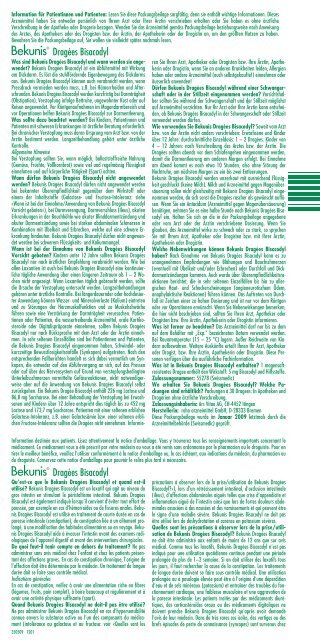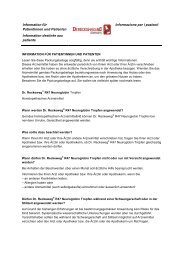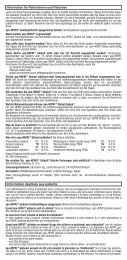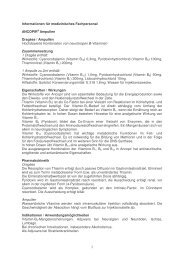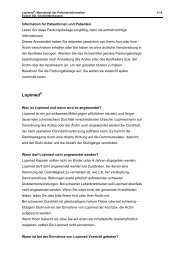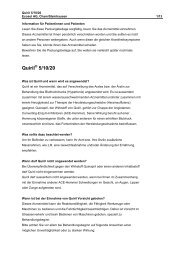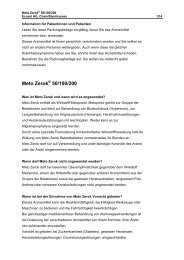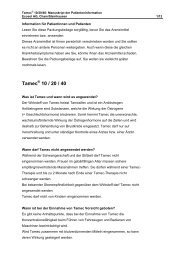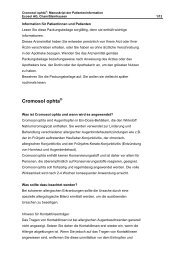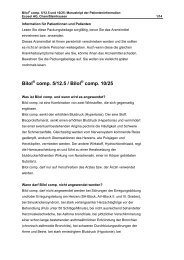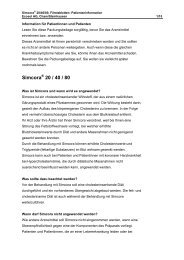Dragées Bisacodyl Dragées Bisacodyl
Dragées Bisacodyl Dragées Bisacodyl
Dragées Bisacodyl Dragées Bisacodyl
You also want an ePaper? Increase the reach of your titles
YUMPU automatically turns print PDFs into web optimized ePapers that Google loves.
Information für Patientinnen und Patienten: Lesen Sie diese Packungsbeilage sorgfältig, denn sie enthält wichtige Informationen. Dieses<br />
Arzneimittel haben Sie entweder persönlich von Ihrem Arzt oder Ihrer Ärztin verschrieben erhalten oder Sie haben es ohne ärztliche<br />
Verschreibung in der Apotheke oder Drogerie bezogen. Wenden Sie das Arzneimittel gemäss Packungsbeilage beziehungsweise nach Anweisung<br />
des Arztes, des Apothekers oder des Drogisten bzw. der Ärztin, der Apo the kerin oder der Drogistin an, um den größten Nutzen zu haben.<br />
Bewahren Sie die Packungsbeilage auf, Sie wollen sie vielleicht später nochmals lesen.<br />
<strong>Dragées</strong> <strong>Bisacodyl</strong><br />
Was sind Bekunis <strong>Dragées</strong> <strong>Bisacodyl</strong> und wann werden sie angewen<br />
det? Bekunis <strong>Dragées</strong> <strong>Bisacodyl</strong> ist ein Abführmittel mit Wirkung<br />
am Dickdarm. Es löst die stuhlfördernde Eigenbewegung des Dickdarms<br />
aus. Bekunis <strong>Dragées</strong> <strong>Bisacodyl</strong> können auch verabreicht werden, wenn<br />
Pressdruck vermieden werden muss, z.B. bei Hämorrhoiden und Afterschrunden.<br />
Bekunis <strong>Dragées</strong> <strong>Bisacodyl</strong> werden kurzfristig bei Darmträgheit<br />
(Obstipation), Verstopfung infolge Bettruhe, ungewohnter Kost oder auf<br />
Reisen angewendet. Vor Röntgenaufnahmen im Magendarmbereich und<br />
vor Operationen helfen Bekunis <strong>Dragées</strong> <strong>Bisacodyl</strong> zur Darmentleerung.<br />
Was sollte dazu beachtet werden? Bei Kindern, Patientinnen und<br />
Patienten mit schweren Erkrankungen ist ärztliche Beratung erforderlich.<br />
Bei chronischer Verstopfung muss deren Ursprung vom Arzt bzw. von der<br />
Ärztin bestimmt werden. Langzeitbehandlung gehört unter ärzt liche<br />
Kontrolle.<br />
Allgemeine Hinweise<br />
Bei Verstopfung sollten Sie, wenn möglich, ballaststoffreiche Nahrung<br />
(Gemüse, Früchte, Vollkornbrot) sowie viel und regelmässig Flüssigkeit<br />
einnehmen und auf körperliche Tätigkeit (Sport) achten.<br />
Wann dürfen Bekunis <strong>Dragées</strong> <strong>Bisacodyl</strong> nicht angewendet<br />
werden? Bekunis <strong>Dragées</strong> <strong>Bisacodyl</strong> dürfen nicht angewendet werden<br />
bei bekannter Überempfindlichkeit gegenüber dem Wirkstoff oder<br />
einem der Inhaltsstoffe (Galactose- und Fructose-Intoleranz: siehe<br />
«Wann ist bei der Einnahme/Anwendung von Bekunis <strong>Dragées</strong> <strong>Bisacodyl</strong><br />
Vorsicht geboten»), bei Darmverengung, Darmverschluss (Ileus), akuten<br />
Erkrankungen in der Bauchhöhle wie akuter Blinddarmentzündung und<br />
akuter Darmentzündung sowie bei starken abdominalen Schmerzen in<br />
Kombination mit Übelkeit und Erbrechen, welche auf eine schwere Erkrankung<br />
hindeuten. Bekunis <strong>Dragées</strong> <strong>Bisacodyl</strong> dürfen nicht angewendet<br />
werden bei schwerem Flüssigkeits- und Kaliummangel.<br />
Wann ist bei der Einnahme von Bekunis <strong>Dragées</strong> <strong>Bisacodyl</strong><br />
Vorsicht geboten? Kindern unter 12 Jahre sollten Bekunis <strong>Dragées</strong><br />
<strong>Bisacodyl</strong> nur nach ärztlicher Empfehlung verabreicht werden. Wie bei<br />
allen Laxantien ist auch bei Bekunis <strong>Dragées</strong> <strong>Bisacodyl</strong> eine kontinuierliche<br />
tägliche Anwendung über einen längeren Zeitraum als 1 – 2 Wochen<br />
nicht angezeigt. Wenn Laxantien täglich gebraucht werden, sollte<br />
die Ursache der Verstopfung untersucht werden. Langzeitbehandlungen<br />
gehören unter ärztliche Kontrolle. Bei längerdauernder oder hochdosierter<br />
Anwendung können Wasser- und Mineralverluste (Kalium) eintreten<br />
und zu Störungen der Herzmuskelfunktion und zu Muskelschwäche<br />
führen sowie eine Verstärkung der Darmträgheit verursachen. Patientinnen<br />
oder Patienten, die wassertreibende Arzneimittel, orale Kortikosteroide<br />
oder Digitalispräparate einnehmen, sollten Bekunis <strong>Dragées</strong><br />
<strong>Bisacodyl</strong> nur nach Rücksprache mit dem Arzt oder der Ärztin einnehmen.<br />
In sehr seltenen Einzelfällen sind bei Patientinnen und Patienten,<br />
die Bekunis <strong>Dragées</strong> <strong>Bisacodyl</strong> eingenommen haben, Schwindel- oder<br />
kurzzeitige Bewusst losigkeitsanfälle (Synkopen) aufgetreten. Nach den<br />
entsprechenden Fallberichten handelt es sich dabei vermutlich um Synkopen,<br />
die entweder auf den Abführvorgang an sich, auf das Pressen<br />
oder auf über das Nervensystem auf Grund von verstopfungsbedingten<br />
Unterleibsschmerzen vermittelte Gefässreaktionen, nicht notwendigerweise<br />
aber auf die Anwendung von Bekunis <strong>Dragées</strong> <strong>Bisacodyl</strong> selbst<br />
zurückgehen. Ein Bekunis Dragée <strong>Bisacodyl</strong> enthält 226 mg Lactose und<br />
86,8 mg Saccharose. Bei einer Behandlung der Verstopfung bei Erwachsenen<br />
und Kindern über 12 Jahre entspricht dies täg lich bis zu 452 mg<br />
Lactose und 173,7 mg Saccharose. Patienten mit einer seltenen erblichen<br />
Galactose-Intoleranz, z.B. einer Galactosämie bzw. einer seltenen erblichen<br />
Fructose-Intoleranz sollten die <strong>Dragées</strong> nicht einnehmen. Informie-<br />
Qu’estce que le Bekunis <strong>Dragées</strong> <strong>Bisacodyl</strong> et quand estil<br />
utilisé? Bekunis <strong>Dragées</strong> <strong>Bisacodyl</strong> est un laxatif qui agit au niveau du<br />
gros intestin en stimulant le péristaltisme intestinal. Bekunis <strong>Dragées</strong><br />
<strong>Bisacodyl</strong> est également indiqué lorsqu’il convient d’éviter tout effort de<br />
poussée, par exemple en cas d’hémorroïdes ou de fissures anales. Bekunis<br />
<strong>Dragées</strong> <strong>Bisacodyl</strong> est utilisé en traitement de courte durée en cas de<br />
paresse intestinale (constipation), de constipation liée à un alitement pro -<br />
longé, à une modification des habitudes alimentaires ou en voyage. Bekunis<br />
<strong>Dragées</strong> <strong>Bisacodyl</strong> aide à évacuer l’intestin avant des examens radiologiques<br />
de l’appareil digestif et avant des interventions chirurgicales.<br />
De quoi fautil tenir compte en dehors du traitement? Ne pas<br />
administrer sans avis médical chez l’enfant et chez les patients présentant<br />
des affections graves. En cas de constipation chronique, l’origine de<br />
l’affection doit être déterminée par le médecin. Un traitement de longue<br />
durée doit se faire sous contrôle médical.<br />
Indications générales<br />
En cas de constipation, veillez à avoir une alimentation riche en fibres<br />
(légumes, fruits, pain complet), à boire beaucoup et régulièrement et à<br />
avoir une activité physique suffisante (sport).<br />
Quand Bekunis <strong>Dragées</strong> <strong>Bisacodyl</strong> ne doitil pas être utilisé?<br />
Ne pas administrer Bekunis <strong>Dragées</strong> <strong>Bisacodyl</strong> en cas d’hypersensibilité<br />
connue envers la substance active ou l’un des composants du médicament<br />
(intolérance au galactose et au fructose: voir «Quelles sont les<br />
350509 1201<br />
ren Sie Ihren Arzt, Apotheker oder Drogisten bzw. Ihre Ärztin, Apothekerin<br />
oder Drogistin, wenn Sie an anderen Krankheiten leiden, Allergien<br />
haben oder andere Arzneimittel (auch selbstgekaufte!) einnehmen oder<br />
äusserlich anwenden!<br />
Dürfen Bekunis <strong>Dragées</strong> <strong>Bisacodyl</strong> während einer Schwangerschaft<br />
oder in der Stillzeit eingenommen werden? Vorsichtshalber<br />
sollten Sie während der Schwangerschaft und der Stillzeit möglichst<br />
auf Arzneimittel verzichten. Nur Ihr Arzt oder Ihre Ärztin kann entscheiden,<br />
ob Bekunis <strong>Dragées</strong> <strong>Bisacodyl</strong> in der Schwangerschaft oder Stillzeit<br />
verwendet werden dürfen.<br />
Wie verwenden Sie Bekunis <strong>Dragées</strong> <strong>Bisacodyl</strong>? Soweit vom Arzt<br />
bzw. von der Ärztin nicht anders verschrieben: Erwachsene und Kinder<br />
über 12 Jahre: durchschnittliche Einzeldosis: 1 – 2 <strong>Dragées</strong>. Kinder von<br />
4 – 12 Jahren: nach Verschreibung des Arztes bzw. der Ärztin. Die<br />
<strong>Dragées</strong> sollten abends vor dem Schlafengehen eingenommen werden,<br />
damit die Darmentleerung am anderen Morgen erfolgt. Bei Einnahme<br />
am Abend kommt es nach etwa 10 Stunden, also ohne Störung der<br />
Nachtruhe, am nächsten Morgen zu ein bis zwei Entleerungen.<br />
Bekunis <strong>Dragées</strong> <strong>Bisacodyl</strong> werden unzerkaut mit ausreichend Flüssigkeit<br />
geschluckt (keine Milch). Milch und Arzneimittel gegen Magenübersäuerung<br />
sollen nicht gleichzeitig mit Bekunis <strong>Dragées</strong> <strong>Bisacodyl</strong> eingenommen<br />
werden, da sich sonst die <strong>Dragées</strong> rascher als gewünscht auflösen.<br />
Wenn Sie ein Antacidum (Arzneimittel gegen Magenübersäuerung)<br />
benötigen, nehmen Sie es eine halbe Stunde nach Bekunis <strong>Dragées</strong> <strong>Bisacodyl</strong><br />
ein. Halten Sie sich an die in der Packungsbeilage angegebene<br />
oder vom Arzt oder der Ärztin verschriebene Dosierung. Wenn Sie<br />
glauben, das Arzneimittel wirke zu schwach oder zu stark, so sprechen<br />
Sie mit Ihrem Arzt, Apotheker oder Drogisten bzw. mit Ihrer Ärztin,<br />
Apothekerin oder Drogistin.<br />
Welche Nebenwirkungen können Bekunis <strong>Dragées</strong> <strong>Bisacodyl</strong><br />
haben? Nach Einnahme von Bekunis <strong>Dragées</strong> <strong>Bisacodyl</strong> kann es zu<br />
unangenehmen Empfindungen wie Blähungen und Bauchschmerzen<br />
(eventuell mit Übelkeit und/oder Erbrechen) oder Durchfall und Dickdarmentzündungen<br />
kommen. Auch wurde über Überempfindlichkeitsreaktionen<br />
berichtet, die in sehr seltenen Einzelfällen bis hin zu allergischen<br />
Haut- und Schockerscheinungen (angioneurotischem Ödem,<br />
anaphylaktische Reaktionen) führen können. Das Auftreten von Durchfall<br />
ist Zeichen einer zu hohen Dosierung und ist nur vor dem Röntgen<br />
oder vor Operationen erwünscht. Wenn Sie Nebenwirkungen bemerken,<br />
die hier nicht beschrieben sind, sollten Sie Ihren Arzt, Apotheker oder<br />
Drogisten bzw. Ihre Ärztin, Apothekerin oder Drogistin informieren.<br />
Was ist ferner zu beachten? Das Arzneimittel darf nur bis zu dem<br />
auf dem Behälter mit „Exp.“ bezeichneten Datum verwendet werden.<br />
Bei Raumtemperatur (15 – 25 °C) lagern. Außer Reichweite von Kindern<br />
aufbewahren. Weitere Auskünfte erteilt Ihnen Ihr Arzt, Apotheker<br />
oder Drogist, bzw. Ihre Ärztin, Apothekerin oder Drogistin. Diese Personen<br />
verfügen über die ausführliche Fach infor ma tion.<br />
Was ist in Bekunis <strong>Dragées</strong> <strong>Bisacodyl</strong> enthalten? 1 magensaftresistentes<br />
Dragee enthält den Wirkstoff: 5 mg <strong>Bisacodyl</strong> und Hilfsstoffe.<br />
Zulassungsnummer: 55278 (Swissmedic)<br />
Wo erhalten Sie Bekunis <strong>Dragées</strong> <strong>Bisacodyl</strong>? Welche Packungen<br />
sind erhältlich? Packungen à 30 Dragees: In Apotheken und<br />
Drogerien ohne ärztliche Verschreibung.<br />
Zulassungsinhaberin: Ars Vitae AG, CH-4452 Itingen<br />
Herstellerin: roha arzneimittel GmbH, D-28333 Bremen<br />
Diese Packungsbeilage wurde im Januar 2009 letztmals durch die<br />
Arzneimittelbehörde (Swissmedic) geprüft.<br />
Information destinée aux patients. Lisez attentivement la notice d’emballage. Vous y trouverez tous les renseignements importants concernant le<br />
médicament. Ce médicament vous a été prescrit par votre médecin ou vous a été remis sans ordonnance par le pharmacien ou le droguiste. Pour en<br />
tirer le meilleur bénéfice, veuillez l’utiliser conformément à la notice d’emballage ou, le cas échéant, aux indications du médecin, du pharmacien ou<br />
du droguiste. Conservez cette notice d’emballage pour pouvoir le relire plus tard si nécessaire.<br />
<strong>Dragées</strong> <strong>Bisacodyl</strong><br />
précautions à observer lors de la prise/utilisation de Bekunis <strong>Dragées</strong><br />
<strong>Bisacodyl</strong>?»), lors d’un rétrécissement intes tinal, d’occlusion intestinale<br />
(iléus), d’affections abdominales aiguës telles que crise d’appendicite et<br />
inflammation aiguë de l’intestin ainsi que lors de fortes douleurs abdominales<br />
associées à des nausées et des vomissements et qui peuvent être<br />
le signe d’une maladie sévère. Bekunis <strong>Dragées</strong> <strong>Bisacodyl</strong> ne doit pas<br />
être utilisé lors de déshydratation et carence en potassium sévères.<br />
Quelles sont les précautions à observer lors de la prise/utilisation<br />
de Bekunis <strong>Dragées</strong> <strong>Bisacodyl</strong>? Bekunis <strong>Dragées</strong> <strong>Bisacodyl</strong><br />
ne doit être administré aux enfants de moins de 12 ans que sur avis<br />
médical. Comme tous les laxatifs, Bekunis <strong>Dragées</strong> <strong>Bisacodyl</strong> n’est pas<br />
indiqué pour une utilisation quotidienne continue pendant une période<br />
prolongée de plus de 1–2 semaine. Si on doit utiliser des laxatifs tous<br />
les jours, il faut rechercher la cause de la constipation. Les traitements<br />
de longue durée doivent se faire sous contrôle médical. Une utilisation<br />
prolongée ou à posologie élevée peut être à l’origine d’une déperdition<br />
d’eau et de sels minéraux (potassium) et entraîner des troubles du fonctionnement<br />
cardiaque, une faiblesse musculaire et une aggravation de<br />
la paresse intestinale. Les patients traités par des médicaments diurétiques,<br />
des corticostéroïdes oraux ou des médicaments digitaliques ne<br />
doivent prendre Bekunis <strong>Dragées</strong> <strong>Bisacodyl</strong> qu’après avoir demandé<br />
l’avis de leur médecin. Dans de très rares cas isolés, des vertiges ou des<br />
brefs épisodes de perte de connaissance (syncopes) sont survenus chez<br />
21200094_Bekiunis_PB_Dragees_CH.indd 1 12.01.12 13:58
des patients ayant pris Bekunis <strong>Dragées</strong> <strong>Bisacodyl</strong>. Selon les rapports de<br />
ces cas, il s’agit probablement de syncopes qui sont soit dues au processus<br />
de défécation en soi, aux contractions, soit aux réactions vasculaires<br />
produites par le système nerveux en réponse aux douleurs abdominales<br />
provoquées par la constipation, et pas nécessairement à l’utilisation de<br />
Bekunis <strong>Dragées</strong> <strong>Bisacodyl</strong> seul. Une dragée Bekunis <strong>Dragées</strong> <strong>Bisacodyl</strong><br />
contient 226 mg de lactose et 86,8 mg de saccharose. Lors d’un traitement<br />
de la constipation chez les adultes et les enfants de plus de 12 ans,<br />
cela représente jusqu’à 452 mg de lactose et 173,7 mg de saccharose<br />
par jour. Les patients atteints d’une rare intolérance héréditaire au galactose<br />
(par ex. galactosémie) ou d’une rare intolérance héréditaire au<br />
fructose ne doivent pas prendre les dragées. Veuillez informer votre<br />
médecin, votre pharmacien ou votre droguiste si vous souffrez d’une<br />
autre maladie, vous êtes allergique, vous prenez déjà d’autres médicaments<br />
en usage interne ou externe (même en automédication!).<br />
Bekunis <strong>Dragées</strong> <strong>Bisacodyl</strong> peutil être pris/utilisé pendant la<br />
grossesse ou l’allaitement? Par mesure de précaution, vous devriez<br />
renoncer si possible à prendre des médicaments durant la grossesse et<br />
l’allaitement. Seul votre médecin peut décider si vous pouvez utiliser Bekunis<br />
<strong>Dragées</strong> <strong>Bisacodyl</strong> pendant la grossesse ou la période d’allaitement.<br />
Comment utiliser Bekunis <strong>Dragées</strong> <strong>Bisacodyl</strong>? Sauf indication<br />
contraire: <strong>Dragées</strong><br />
Adultes et enfants de plus de 12 ans: dose unitaire moyenne: 1 à 2 dragées.<br />
Enfants de 4 à 12 ans: selon les indications du médecin. Prendre les<br />
dragées le soir au coucher afin que l’évacuation des selles ait lieu le<br />
lendemain matin. Lorsque les dragées sont ingérées le soir, l’action laxative<br />
se manifeste au bout d’environ 10 heures sans perturber le sommeil<br />
et entraîne l’évacuation d’une ou de deux selles le lendemain matin.<br />
Avaler les dragées Bekunis <strong>Dragées</strong> <strong>Bisacodyl</strong> sans les croquer avec suffisamment<br />
de liquide (pas de lait). Ne pas absorber de lait ni de médicaments<br />
antacides en même temps que les dragées Bekunis <strong>Dragées</strong> <strong>Bisacodyl</strong>,<br />
sinon les dragées se dissolvent plus vite que souhaité. Si un antacide<br />
(médicament contre l’excès d’acidité gastrique) est nécessaire, il faut<br />
le prendre une demi-heure au moins après le Bekunis <strong>Dragées</strong> <strong>Bisacodyl</strong>.<br />
Veuillez vous conformer au dosage figurant dans le prospectus ou prescrit<br />
par votre médecin. Si vous avez l’impression que l’efficacité du médicament<br />
est trop faible ou au contraire trop forte, veuillez vous adresser à<br />
votre médecin, votre pharmacien ou à votre droguiste.<br />
Quels effets secondaires Bekunis <strong>Dragées</strong> <strong>Bisacodyl</strong> peutil<br />
provoquer? Des sensations désagréables telles que des ballonnements<br />
ou des douleurs abdominales (éventuellement avec nausées et/ou vomissements)<br />
ou des diarrhées et une inflammation du gros intestin<br />
peuvent survenir suite à la prise de Bekunis <strong>Dragées</strong> <strong>Bisacodyl</strong>. Des<br />
réactions d’hypersensibilité, qui dans de très rares cas isolés peuvent<br />
conduire jusqu’à des réactions allergiques cutanées et la survenue de<br />
chocs allergiques (oedème angioneurotique, réactions anaphylactiques),<br />
ont également été rapportées. L’apparition de diarrhées est le signe<br />
d’une dose trop élevée et n’est recherchée qu’en cas de préparation aux<br />
examens radiolo giques ou avant une intervention chirurgicale. Si vous<br />
remarquez d’autres effets secondaires, veuillez en informer votre médecin,<br />
votre pharmacien ou votre droguiste.<br />
A quoi fautil encore faire attention? Bekunis <strong>Dragées</strong> <strong>Bisacodyl</strong><br />
doit être conservé hors de portée des enfants. Protéger les dragées de<br />
l’humidité et conserver-les à température ambiante (15–25 °C). Le<br />
médicament ne doit être utilisé au-delà de la date figurant après la<br />
mention «EXP» sur le récipient. Pour de plus amples renseignements,<br />
consultez votre médecin, votre pharmacien ou votre droguiste, qui disposent<br />
d’une information détaillée destinée aux professionnels.<br />
Que contient Bekunis <strong>Dragées</strong> <strong>Bisacodyl</strong>? <strong>Dragées</strong><br />
Principe actif: 5 mg de bisacodyl, excipients pour dragée.<br />
Numéro d’autorisation 55278 (Swissmedic).<br />
Où obtenezvous Bekunis <strong>Dragées</strong> <strong>Bisacodyl</strong>? Quels sont les<br />
emballages à disposition sur le marché? En pharmacie et en droguerie,<br />
sans ordonnance médicale: <strong>Dragées</strong> à 5 mg: 30.<br />
Titulaire de l’autorisation : Ars Vitae AG, CH-4452 Itingen.<br />
Productrice: roha arzneimittel GmbH, D-28333 Bremen<br />
Cette notice d’emballage a été vérifiée pour la dernière fois en janvier<br />
2009 par l’autorité de contrôle des médicaments (Swissmedic).<br />
Informazione destinata ai pazienti Legga attentamente il foglietto illustrativo che contiene importanti informazioni. Questo medicamento le è<br />
stato prescritto dal suo medico o le è stato consegnato senza prescrizione medica in farmacia o in drogheria. Per ottenere il maggior beneficio usi il<br />
medicamento conformemente al foglietto illustrativo o segua le indica zioni del suo medico, del suo farmacista o del suo droghiere. Conservi il fog lietto<br />
illustrativo per poterlo rileggere all’occorrenza.<br />
<strong>Dragées</strong> <strong>Bisacodyl</strong><br />
Che cos’è il Bekunis <strong>Dragées</strong> <strong>Bisacodyl</strong> e quando si usa? Il Bekunis<br />
<strong>Dragées</strong> <strong>Bisacodyl</strong> è un lassativo che agisce a livello dell’intestino crasso.<br />
Provoca i movimenti propri dell’intestino crasso che favoriscono la defecazione.<br />
Il Bekunis <strong>Dragées</strong> <strong>Bisacodyl</strong> si può somministrare anche quando si<br />
deve evitare di spingere nell’intento di andar di corpo, p. es. in presenza di<br />
emorroidi e di fessure anali. Il Bekunis <strong>Dragées</strong> <strong>Bisacodyl</strong> si usa a breve<br />
scadenza in caso di pigrizia intestinale (costipazione), stitichezza conseguente<br />
a degenza a letto, ad alimentazione insolita o che insorge in viaggio.<br />
Prima di esami radiologici nell’ambito gastro-intestinale e prima di<br />
un’operazione il Bekunis <strong>Dragées</strong> <strong>Bisacodyl</strong> aiuta ad evacuare l’intestino.<br />
Di che cosa occorre inoltre tener conto durante il trattamento?<br />
Nei bambini e nei pazienti con malattie gravi è necessario il consiglio del<br />
medico. In presenza di stitichezza cronica spetta al medico stabilirne<br />
l’origine. La terapia a lunga scadenza richiede un controllo medico.<br />
Avvertenze generali<br />
In caso di stitichezza, se possibile dovrebbe provvedere ad un’ali mentazione<br />
ricca di sostanze inerti (verdura, frutta, pane integrale), a bere<br />
molto e regolarmente ed a svolgere attività fisica (sport).<br />
Quando non si può assumere/usare il Bekunis <strong>Dragées</strong> <strong>Bisacodyl</strong>?<br />
Il Bekunis <strong>Dragées</strong> <strong>Bisacodyl</strong> non si può usare in caso di ipersensibilità<br />
conosciuta al principio attivo o ad uno dei costituenti (intolleranza<br />
al galattosio e al fruttosio: vedi «Quando è richiesta prudenza nella<br />
somministrazione/nell’uso del Bekunis <strong>Dragées</strong> <strong>Bisacodyl</strong>?»), di stenosi<br />
(restringimento) dell’intestino, di occlusione intestinale (ileo), di malattie<br />
acute nella cavità addominale quali appendicite acuta e infiammazione<br />
intestinale acuta, come pure di forti dolori addominali associati a nausea<br />
e vomito che sono indizi di una malattia grave. Il Bekunis <strong>Dragées</strong> Besicodyl<br />
non si deve usare in caso di grave carenza di liquido e di potassio.<br />
Quando è richiesta prudenza nella somministrazione/nell’uso<br />
del Bekunis <strong>Dragées</strong> <strong>Bisacodyl</strong>? Ai bambini sotto 12 anni il Bekunis<br />
<strong>Dragées</strong> <strong>Bisacodyl</strong> si può somministrare soltanto su consiglio del medico.<br />
Come per tutti lassativi, anche per il Bekunis <strong>Dragées</strong> <strong>Bisacodyl</strong> non è<br />
indicato un uso quotidiano continuato per un periodo di tempo superiore<br />
a 1 – 2 settimane. Se si usano tutti i giorni dei lassativi bisogna cercare<br />
la causa della stitichezza. Le terapie a lunga scadenza richiedono un<br />
controllo medico. In caso di uso a lunga scadenza od a posologia elevata<br />
possono verificarsi perdite d’acqua e di sostanze minerali (potassio) e<br />
determinare disturbi della funzionalità del miocardio (muscolo del cuore)<br />
e debolezza muscolare come pure aggravare la stitichezza. I pazienti che<br />
prendono diuretici (farmaci per aumentare l’escrezione urinaria), corticosteroidi<br />
per via orale o preparati a base di digitale devono assumere il<br />
Bekunis <strong>Dragées</strong> <strong>Bisacodyl</strong> solo dopo aver consultato il medico. In singoli<br />
casi molto rari, in pazienti che hanno assunto Bekunis <strong>Dragées</strong> <strong>Bisacodyl</strong><br />
si sono verificati degli attacchi di vertigini o di perdita della conoscenza<br />
di breve durata (sincopi). Secondo i rapporti relativi a questi casi si<br />
tratta presumibilmente di sincopi imputabili al processo di defecazione in<br />
sé, al fatto di spengere od a reazioni vascolari trasmesse tramite il sistema<br />
nervoso a causa di dolori al basso ventre dovuti alla stitichezza, ma<br />
non necessariamente all’uso del Bekunis <strong>Dragées</strong> <strong>Bisacodyl</strong> come tale.<br />
Un confetto di Bekunis <strong>Dragées</strong> <strong>Bisacodyl</strong> contiene 226 mg di lattosio e<br />
86,8 mg di saccarosio. In un trattamento della stitichezza negli adulti e<br />
nei bambini oltre i 12 anni ciò corrisponde a una dose giornaliera fino a<br />
452 mg di lattosio e 173,7 mg di saccarosio. I pazienti che soffrono di<br />
una rara intolleranza ereditaria al galattosio, p. es. una galattosemia,<br />
oppure di una rara intolleranza ereditaria al fruttosio non devono assumere<br />
i confetti. Informi il suo medico, il suo farmacista o il suo droghiere<br />
nel caso in cui soffra di altre malattie, soffra di allergie o assuma o applichi<br />
per uso esterno altri medicamenti (anche se acquistati di sua iniziativa!).<br />
Si può assumere/usare il Bekunis <strong>Dragées</strong> <strong>Bisacodyl</strong> durante<br />
la gravidanza o l’allattamento? Per prudenza dovrebbe rinunciare<br />
nella misura del possibile ad usare medicamenti durante la gravidanza<br />
e l’allattamento. Solo il suo medico può decidere se si deve usare il Bekunis<br />
<strong>Dragées</strong> <strong>Bisacodyl</strong> durante la gravidanza o l’allattamento.<br />
Come usare il Bekunis <strong>Dragées</strong> <strong>Bisacodyl</strong>? Salvo diversa prescrizione<br />
del medico: Adulti e bambini oltre i 12 anni: dose singola media:<br />
1 – 2 confetti. Bambini da 4 a 12 anni: secondo la prescrizione del<br />
medico. Prendere i confetti alla sera prima di coricarsi affinché l’evacuazione<br />
avvenga la mattina successiva. Se si prende il medicamento alla<br />
sera, dopo circa 10 ore, cioè senza disturbare il riposo notturno, la mattina<br />
successiva si hanno da una a due defecazioni. Deglutire i confetti<br />
Bekunis <strong>Dragées</strong> <strong>Bisacodyl</strong> senza masticarli, con una quantità sufficiente<br />
di liquido (non latte). Latte e medicamenti contro l’iperacidità di stomaco<br />
non vanno presi contemporaneamente ai confetti Bekunis <strong>Dragées</strong> <strong>Bisacodyl</strong>,<br />
perché altrimenti i confetti si sciolgono più rapidamente del voluto.<br />
Se le occorre un antiacido (medicamento contro l’iperacidità di stomaco)<br />
lo prenda mezz’ora dopo il Bekunis <strong>Dragées</strong> <strong>Bisacodyl</strong>. Si attenga alla<br />
posologia indicata nel foglietto illustrativo o prescritta dal medico. Se<br />
ritiene che l‘azione del medicamento sia troppo debole o troppo forte ne<br />
parli al suo medico, al suo farmacista o al suo droghiere.<br />
Quali effetti collaterali può avere Bekunis <strong>Dragées</strong> <strong>Bisacodyl</strong>?<br />
Dopo l’assunzione del Bekunis <strong>Dragées</strong> <strong>Bisacodyl</strong> possono manifestarsi<br />
delle sensazioni sgradevoli quali meteorismo e dolori di ventre (eventualmente<br />
con nausea e/o vomito) o diarrea e infiammazioni dell’intestino<br />
crasso. Sono pure state riferite delle reazioni d’ ipersensibilità, che in<br />
singoli casi molto rari possono arrivare a provocare dei fenomeni allergici<br />
a livello della pelle e sotto forma di shock (edema angioneurotico,<br />
reazioni anafilattiche). Se si verifica diarrea è segno che la dose è troppo<br />
elevata; questo effetto è auspicabile soltanto prima di esami radiologici<br />
o di un’operazione. Se osserva effetti collaterali qui non descritti dovrebbe<br />
informare il suo medico, farmacista o il suo droghiere.<br />
Di che alto occorre tener conto? Conservare il Bekunis <strong>Dragées</strong> <strong>Bisacodyl</strong><br />
fuori dalla portata dei bambini. Proteggere i confetti dall’umidità<br />
e conservare a temperatura ambiente (15 – 25 °C). Il medicamento non<br />
dev’essere utilizzato oltre la data indicata con “EXP” sul contenitore. Il<br />
medico, farmacista o il droghiere, che sono in possesso di documentazione<br />
professionale dettagliata, possono darle ulteriori informazioni.<br />
Cosa contiene il Bekunis <strong>Dragées</strong> <strong>Bisacodyl</strong>? Principi attivi: bisacodile<br />
5 mg, sostanze ausiliarie per confetto.<br />
Numeri dell’omologazione 55278 (Swissmedic)<br />
Dov’ è ottenibile il Bekunis <strong>Dragées</strong> <strong>Bisacodyl</strong>? Quali confezioni<br />
sono disponibili? In farmacia e in drogheria, senza prescrizione medica:<br />
Confetti da 5 mg: 30<br />
Titolare dell’omologazione: Ars Vitae AG, CH-4452 Itingen<br />
Fabriccante: roha arzneimittel GmbH, D-28355 Bremen<br />
Questo foglietto illustrativo è stato controllato l’ultima volta nel gennaio<br />
2009 dall‘autorità competente in materia di medicamenti (Swissmedic).<br />
21200094_Bekiunis_PB_Dragees_CH.indd 2 12.01.12 13:58


